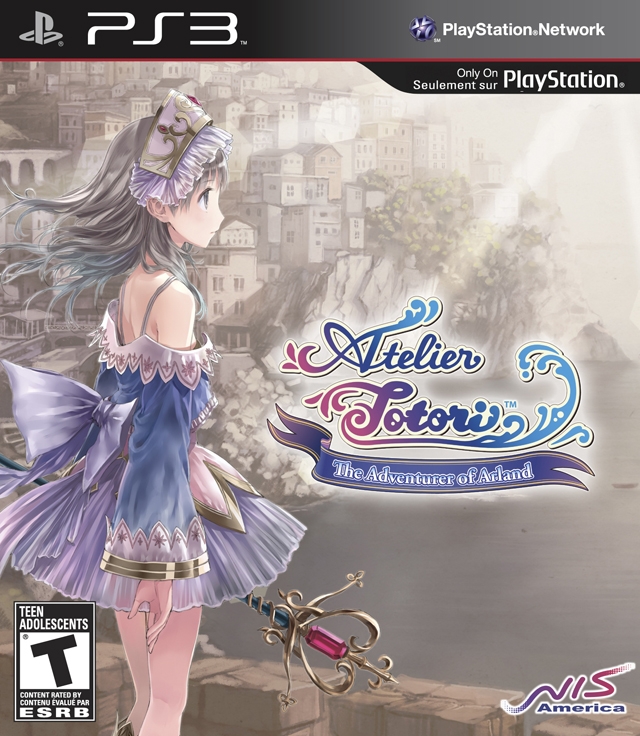
Atelier Totori: The Adventurer of Arland - Review
by Karl Koebke , posted on 11 September 2011 / 12,984 ViewsThe Atelier series is truly a strange beast. Simplistic battle systems and minimal story make room for the almost disturbingly complex item creation system that is the hallmark of the series. Those who tried Atelier Rorona and were put off by this will probably have the same result if they try out Atelier Totori, but those who enjoyed the first will find that Gust has improved upon its game design in all the ways that one would hope, as well as some ways I didn’t see coming at all.
You play as Totori, a 13 year old girl from Alanya (a small village outside of Arland) who has started learning Alchemy under the protagonist of the first game: Rorona. It is 5 years since the events of the first game and a system of licensing for adventurers has been devised by the government. Totori’s mother was one of the first adventurers to gain such a license but it’s been years since the family has heard from her and Totori’s father and sister both assume the worst. Totori refuses to believe this, but in order to search for her mother she needs permission from the government, and that means getting her adventurer’s license.
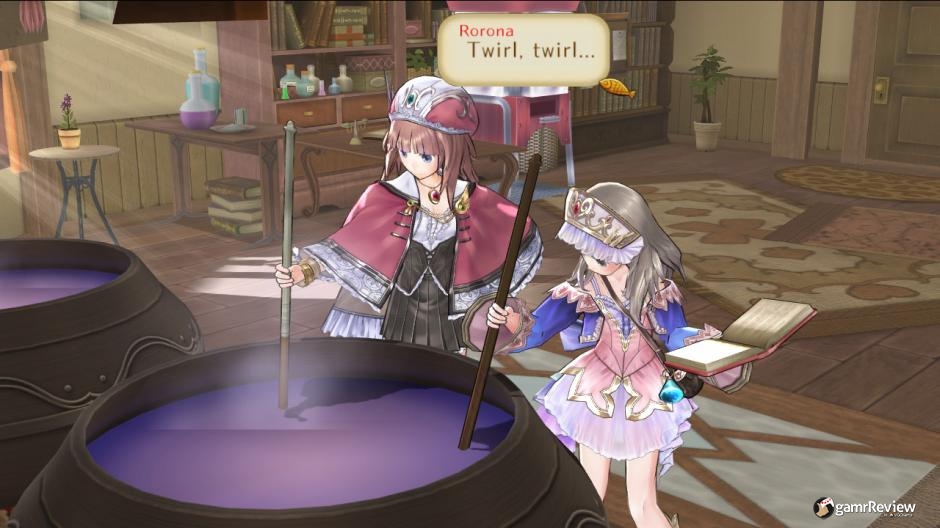
One of my favorite parts about the Atelier series is how the storyline remains personal and almost “slice of life” assuming that that life is that of a mystical alchemist. This remains true in Atelier Totori and means that you are never going to see the storyline ramp up to the world saving antics that most JRPGs get to. Instead what you have is a more personal story which often leans towards trying to get a few chuckles out of the player but had a couple of more meaningful and somber moments particularly linked to the main storyline of Totori looking for her mother. Overall the story was definitely more enjoyable and meaningful than the first game’s while still keeping light hearted for the most part.
Probably a big reason for this is that the requirements for seeing the side characters’ story events are a lot more natural this time around. Instead of building up your relationship with the other characters by synthesizing specific items for them your relationship builds simply by traveling with that character in tow. This system makes a lot more sense and means that you will more than likely see a number of events for each character and get one of their endings as the finale after the credits. On a story related note I also have to mention that while I didn’t find the entire game laugh out loud funny there was an event where two side characters with the same voice actor met to talk about how eerily similar their voices were which was genuinely hilarious.
So apparently you need an adventurer’s license and if Atelier Rorona has taught us anything that means that you’re going to be fulfilling specific quests every three months in order to advance the main plot. Luckily this is where you’re wrong. Although at the time I didn’t find anything particularly wrong with how Rorona’s main storyline progression worked after playing Atelier Totori I don’t think I’d ever want to go back. The main goal of the game is to get a full Adventurer’s license, you quickly get a temporary one but you then have three years to prove yourself worthy of an extension. Instead of giving you specific requests to fulfill you simply need to increase your license to a certain rank by the end of the three years by getting points.
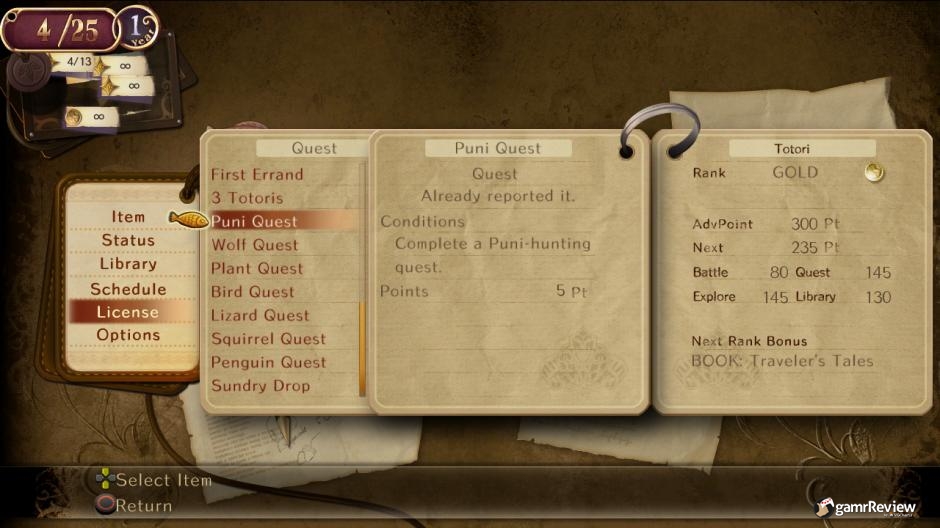
Points are obtained by doing just about anything, really. There are points for alchemy, exploring, defeating monsters, and for fulfilling optional quests. Basically you can advance the main storyline just by screwing around. Getting the necessary number of points is easiest if you dabble in a little bit of each of these activities, but instead of requiring that you do a specific task in a given timeframe like Atelier Rorona, Totori leaves you free to decide what you want to do and when. Later in the game there are a couple of specific goals given that you’ll have to work towards if you want to advance Totori’s storyline, but you are given a huge amount of time to work towards them, so it doesn’t feel as constricting as Atelier Rorona ended up.
Time management is again a huge part of the gameplay in Atelier Totori. While you may think that you have all the time in the world with a total of 5 years of gameplay where the first game had 3 you have to be careful because time is taken up more readily now. In Atelier Rorona time was advanced only when you were traveling to and from a place to adventure or crafting an item in your workshop, but now you also advance in time when battling monsters or picking up items at a gathering point. Luckily these take up fractions of a day instead of being measured in whole days. Gathering will take up half a day at first (this can be decreased later in the game with an item) and battles take a tenth of a day for each turn in combat. There are also two towns that you will have to frequently go between which also takes up time. None of these additions came off as a big hassle since your time constraints are much less stringent than before, but it’s something to think about when you check a gathering point and you don’t direly want anything you find there.
Obviously, since the main character is an alchemist, item creation plays a large part in the game, and it has remained largely unchanged from the first game. Materials you gather still have a number from 1-100 for general quality and then a list of up to 5 traits that affect anything from the success rate of recipes made with that material to bonuses like earth defense or increasing the number of uses of an item made with it. Again, this means that any given plant or mineral you pick up will almost invariably be different from any other one you have picked up even if they had the same name. It’s like how no two snowflakes are exactly the same, but in this case the snow is fertilizer or grapes.
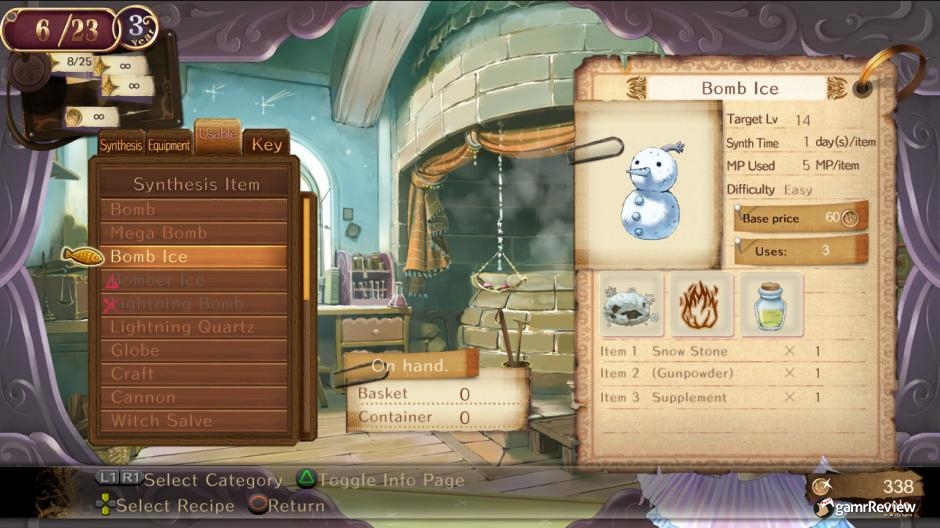
Traits of your ingredients can then be passed on to the items you make with said materials, but the way this is done differs from the first game. Selecting the specific ingredients for your synthesis gives you a list of possible traits that the final product could have with point values for each, and then after you are successful you are given points based on the types of materials you use. For example if a recipe calls for “plants” and you use a tree trunk you found from one of the first areas you could explore it won’t have as many points to use as some bamboo from one of the later areas. This also can change the effect of an item; a bomb you make at the beginning of the game will almost invariably do less damage than one you make with more advanced materials. The final points tally is then used to give the item up to five traits based on what you can afford. My only complaint with this system is that it leaves the bad traits somewhat meaningless; since I didn't see any request that required explicit traits for an item, there was little to no reason to choose a bad trait to give to your synthesis.
Finally we have the battle system, which has been revamped and simplified. You still have a very old school turn based system with no gimmicks, but instead of using your own health points for all of your skills you have a pool of MP which you draw from to use them. This is great because the first game’s health requirements didn’t scale very well with leveling so skills were basically free for the final fights. Using the items you make is still on the forefront of the battle system and perhaps even more so since Totori does not have any non-item based skills of her own to use. Totori is the only character who can use items at first but later you can recruit your teacher Rorona who also has this ability. As in the first game, battles are all about being prepared. Don’t leave home without a couple of healing items and some bombs just in case things get dicey.
Atelier Totori is at its best when you’re roaming around in new areas, defeating new bosses, and getting new materials and recipes. The greater freedom you get means that I spent a lot more time just enjoying the game for what it was instead of sweating over the next quest that I had to turn in. I particularly enjoyed getting new ingots and cloth to give to the blacksmith for new equipment because the qualities of the new armor or weapon are almost entirely dictated by the traits you imbue into the starting material. If you find a new material and synthesize a new type of ingot, that’ll get you a minor boost to attack, but if you can put traits on that ingot like Puni Repel (100% critical rate on Punis), and life siphoning, then you suddenly have a much more unique weapon. You can actually tailor the weapon you make to your specific needs instead of just hoping you find a weapon that does what you want.
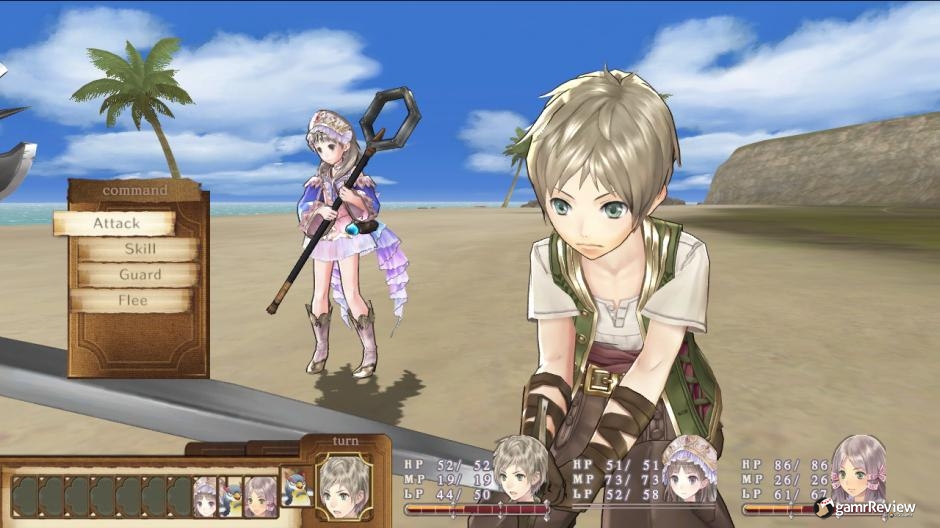
Graphics in Atelier Totori are an improvement from the last game, but not a massive one. Environments are still technically simple with minimal textures. On the plus side characters look great and they actually look much more like the still pictures used for dialogue instead of “chibi” versions. Battle animations are greatly improved and attacks no longer end with your character flying across the median to attack the enemy on the other side (they run now). The artwork you get for certain story events is quite nice to look at, but it doesn’t have the impact for me that a good animated sequence would.
Sound design is similar to the first game and you can switch between Japanese and English voice over even though I personally had little to no issue with the English actors. For some reason I found Pamela the shop keeper’s whispery tones more annoying in this game than the first and the most emotional scene didn’t really hit me like I feel it should have, partly because of looped crying, but for the most part the voice acting is done well. Music is upbeat and worthy of humming along to but didn’t usually add too much to the atmosphere.
My playthrough took me 31 hours which is an improvement from Rorona, but the game's length is highly variable because of the freedom you are given. There are eleven or so possible endings to the game, but the ones I saw fell short to the ending for Totori’s specific arc which I got after about 20 hours. However, I appreciate the ability to continue playing even after you see this event. In the end I felt pretty satisfied with everything I got to do in Atelier Totori and I didn’t feel like the game ended before I got to do all the fun new recipes I found like Rorona did.
Atelier Totori has a number of small improvements all overshadowed by the massive improvement to overall structure. I had no idea how restricting the previous game was until this one gave me complete freedom to do whatever I wanted while still progressing through the storyline. The story is more meaningful and easier to get invested in, the animations are improved, and the alchemy is just as great as you expect from Gust. It still isn’t a game that I could recommend to all JRPG fans because the story and battle system don’t match up to those in the best JRPGs, but fans of the first game should jump in without question, and if you find yourself tired of the old grind towards world saving then give this one a look. If Gust could improve the battle system in particular I think this series could be one of the great ones, but as it stands it’s a fun and interesting diversion from some of the more traditional games in the genre.
VGChartz Verdict
7.6
Good
























